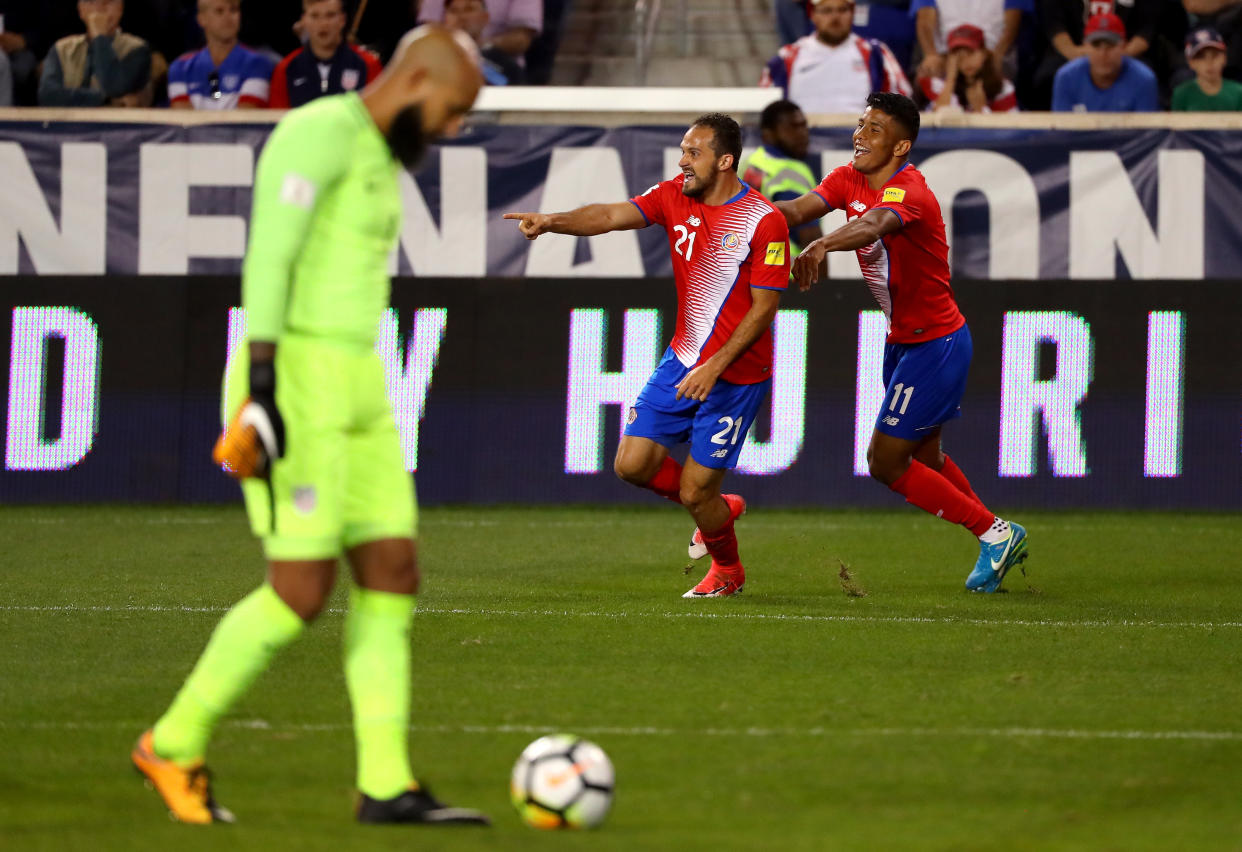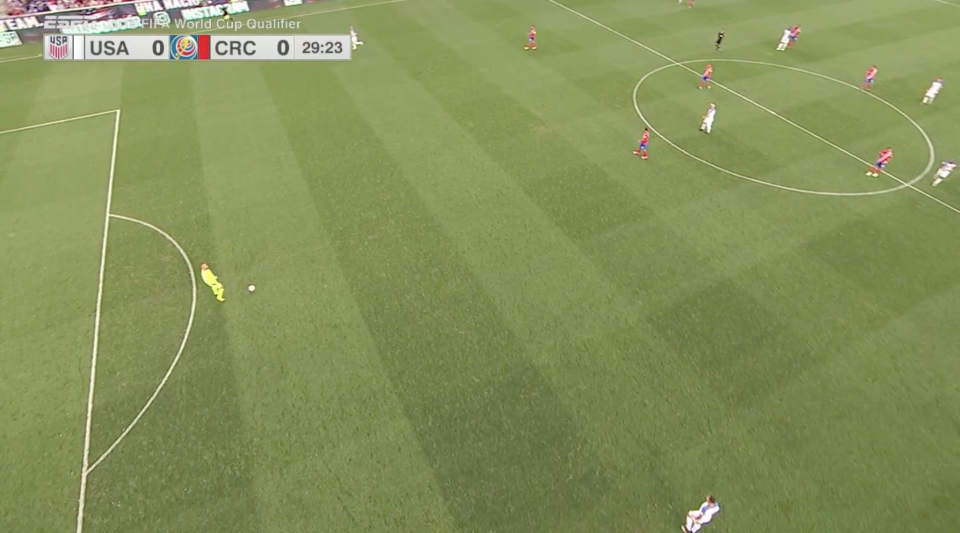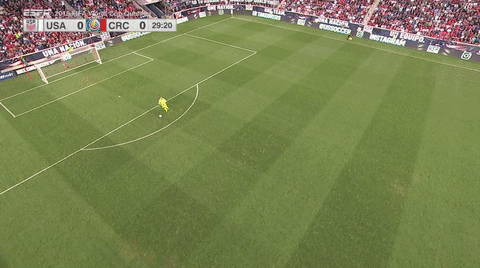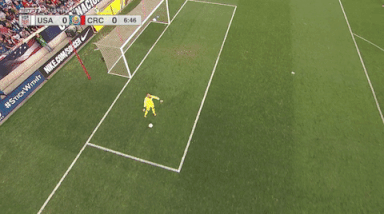The Costa Rica goal that doomed the U.S. was not a defender's fault. It was Tim Howard's.

Tim Howard is arguably the greatest American soccer player ever. At the very least, he’s spent the past decade vacillating between strong starting goalkeeper and national hero. He’s the U.S. men’s national team’s undisputed No. 1, and likely will be at the World Cup nine months from now in Russia.
If, that is, the U.S. qualifies.
And that’s a significant “if,” even if qualification is still a likelihood, after the Americans were shut down and shocked by Costa Rica Friday night. They were stymied at every turn by a dogged defense that battered Christian Pulisic and swallowed up space within 30 yards of goal.
But that defense was enabled by a series of calamitous 30th-minute events, and by a goal that falls not completely but primarily in the lap of Howard. The sequence of mistakes didn’t just end with the ball slithering past him and into the far corner his net, it began with the American goalkeeper as well.
The U.S. was intent on playing out of the back for much of Friday’s match, and early on, it was comfortable and composed when doing so. When Howard had the ball at his feet, the center backs would split, Michael Bradley would check into the space between them, and Howard would often play to one of the three:

Costa Rica’s line of confrontation varied throughout the 90 minutes, but when it was high – when the Ticos put the U.S. under pressure in its own defensive third – the Americans coped fairly well. There were some nervy moments and hiccups. But for every hiccup, there was an outlet and a dangerous attack.
It was both off-putting and extremely encouraging to see Darlington Nagbe evade David Guzman at the edge of his own penalty area and break the Costa Rica pressure just two minutes in:

So how does this tie into Costa Rica’s first goal?
Because, 13 seconds before it was scored, the ball was at Howard’s feet, and the U.S. was prepared to do what it had done for much of the first half: play out of the back. Geoff Cameron and Tim Ream were spread wide, and Ream had just begun to accelerate back toward his own goal line to create space in which to receive a pass. Here’s what the U.S. looked like with Howard in possession – note Ream at the very top of the picture and Cameron to the very bottom:

As you probably know by now, Howard played a long ball, Fabian Johnson lost the aerial duel, Marcos Urena ran into the gaping hole between the center backs, and suddenly the U.S. found itself down 1-0:
GOOOOOL de Marcos Ureña para abrir el marcador a favor de los Ticos. USA 0-1 CRC pic.twitter.com/tkuERqa4Lh
— Univision Deportes (@UnivisionSports) September 1, 2017
There is nothing inherently wrong with Howard playing long, especially as the U.S. struggled to connect passes midway through the first 45. The problems, though – and Howard’s mistake – are in the specifics.
With no Costa Rica player within 30 yards of him, Howard was in no hurry. Or at least he shouldn’t have been. He could direct traffic as he liked. Under no pressure, he had time to inform his center backs of his decision to go long and wave them up the field – as he and other keepers almost always do when starting an attack from nothing.
But that’s exactly what he didn’t do. In this instance, he needlessly rushed, and left both Cameron and Ream in the dark and out of position:

Howard wasn’t totally uncommunicative. He did seem to point forward with his left hand. But neither of his center backs quite got the memo, and Howard gave neither sufficient time to get back to their neutral positions.
Here’s what this looks like when it’s done properly:

A goal kick obviously offers more time to get set, but Howard had all the time in the world before the goal. And the principles are the same. The optimal shape when a team builds from the back is significantly different from its neutral shape, when it must be ready to react to anything. Cameron and Ream were ready to keep possession, not to defend a through-ball.
Neither center back is blameless, and especially not Cameron. Once the ball did go long, he switched off, and his re-positioning lacked urgency. He then half-heartedly tried to play Urena offside rather than recognizing the danger and sprinting back into position.
But he and Ream did eventually recover. And while Ream got “beat” on the goal, he more or less did his job. He pushed Urena toward the sideline, the angle and goal probability of the forward’s shot decreasing with every step. He ultimately forced him into an off-balance lunge at the ball.
He put the play back in Howard’s hands.
And again, surprisingly, the USMNT legend erred.
The shot-stopper extraordinaire was caught wrong-footed, and the lack of burst on his dive back against the grain was excruciating. Howard makes that save eight or nine times out of 10, and 2014 Tim Howard makes it 19 out of 20.
Friday night was the one out of 10, and it was the one goal Costa Rica needed. The Ticos are outstanding with a lead. The goal changed the game more than an opener often does because it allowed the visitors to tighten strings at the back and swarm to the ball without worrying about an attacking outlet.
The U.S. wasn’t as poor as much of the postgame reaction would suggest it was. It had its chances. At 0-0, it looked the more likely of the two teams to score. Had it gone into halftime still tied, it would have been the favorite to win the game.
But it was done in by one moment. One moment that comprised a series of errors. A series of errors bookended by ones from the most unexpected of sources.
– – – – – – –
Henry Bushnell covers soccer – the U.S. national teams, the Premier League, and much, much more – for FC Yahoo and Yahoo Sports. Have a tip? Question? Comment? Email him at henrydbushnell@gmail.com or follow him on Twitter @HenryBushnell.



